
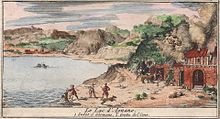

The Cave of Dogs (Italian : Grotta del Cane) is a cave near Naples, Italy. Volcanic gases seeping into the cave give the air inside a high concentration of carbon dioxide. Dogs held inside would faint; at one time this was a tourist attraction.



The Cave of Dogs (Italian : Grotta del Cane) is a cave near Naples, Italy. Volcanic gases seeping into the cave give the air inside a high concentration of carbon dioxide. Dogs held inside would faint; at one time this was a tourist attraction.
The Cave of Dogs (Italian : Grotta del Cane, literally "Cave of the Dog") [1] [2] ) is a cave about ten metres deep on the eastern side of the Phlegraean Fields near Pozzuoli, Naples. [3] Inside the cave is a fumarole that releases carbon dioxide of volcanic origin.
The cave is thought to have been constructed in classical antiquity, possibly as a sudatorium; if so, the CO2 emissions must have been much lower at the time. [1] It may have been known to Pliny the Elder, who, in his Natural History Chapter 95 [4] (written 77–79 AD), mentions a location near Pozzuoli where animals die from poisonous fumes. However, the first unambiguous reports about the cave only appear in the 16th century. [1]
Later, it became a tourist attraction for travelers on the Grand Tour. The CO2 gas, being denser than air, tended to accumulate in the deeper parts of the cave. As a result, small animals such as dogs held inside the cave suffered carbon dioxide poisoning, while a standing human was not affected. [1] [5] Local guides, for a fee, would suspend small animals (usually dogs) inside it until they became unconscious. The dogs could be revived by submerging them in the cold waters of the nearby Lake Agnano, although in at least one case this led to the dog drowning instead. [6] Tourists who came to see this attraction included Sir Thomas Browne, [7] Richard Mead, [8] Goethe, John Evelyn, Montesquieu, [9] Alexandre Dumas père, and Mark Twain. [10]
Dutch traveller Cornelis de Bruijn also reported visiting the caves in the year 1677. He wrote:
Next, one comes close to the road by a small cave called Grotta del Cani, which is very venomous, to the extent that if a dog is kept inside, it dies very quickly. I had the curiosity to visit it with two different dogs and found that when the animal remains standing on its legs, it is not harmed by the poison. However, if one forcibly presses it down, it quickly loses its strength after great struggling and desperate resistance, and would undoubtedly die in an instant if not promptly picked up and thrown into a nearby water or lake, where it immediately recovers but with some dizziness, walking like a human who is completely drunk. This lake has the same nature as the cave and boils in several places due to the great heat of sulfur. Curiosity drove me to investigate how high the venom in the cave might be from the ground, so bowing my head downward, I found it to be only one foot high from the ground. [11]
Some tourists including Washington Irving (1804), [12] Percy Bysshe and Mary Shelley (1818) [13] and Ralph Waldo Emerson (1833), [14] objecting to the cruelty, refused to pay for the experiment to be performed on the dog. A Scottish scientist who examined the cave for several days (1877) reported:
On carrying a lighted torch into the cave, its smoke gradually falls, till it reaches the layer of gas, upon which it settles; and on looking in, the surface of the gaseous layer is seen, resembling that of water, and appears covered with beautiful undulations.
On holding the head below the level of the gas, holding the breath, and keeping the eyes open, an intolerable prickling sensation is produced upon the eyes by the carbonic acid.
A dog brought into the cave, as is the custom there, appears, as it were, to drink the gas, lapping with its tongue. Then its eyes begin to dilate to an unnatural size, and its lapping becomes more spasmodic; beyond this it does not seem to suffer. While in the cave, also, the dog was able to stand, but when carried and set on its feet outside in the fresh air, it fell, and lay struggling as if in paroxysms of suffocation, but recovered in two or three minutes. I was told, however, that the animal gets into such a nervous state with the prospects of its frequent ordeals, that it has to be killed in three months. [15]
The lake became polluted, was thought to be malarious, and was drained in 1870. At some point the spectacle fell into disuse, although Baedeker's guides in the 1880s were still advertising that to see the dog experiment would cost tourists 1 lire (≈ 20 U.S. cents). [16] According to one source, it was banned before World War II for cruelty to animals. The cave entrance was blocked to prevent access by children. [17] [18] [5] [19] [20]
In 2001 the cave was investigated by Italian speleologists. Nine metres from its entrance the temperature was 52 °C (126 °F) and the CO2 concentration was 80%, with negligible oxygen. [1]
The cave was often described in nineteenth century science textbooks to illustrate the density and toxicity of carbon dioxide, [21] and its reputation gave rise to a scientific demonstration of the same name, in which stepped candles are successively extinguished by tipping carbon dioxide into a transparent container.

Carbon dioxide is a chemical compound with the chemical formula CO2. It is made up of molecules that each have one carbon atom covalently double bonded to two oxygen atoms. It is found in the gas state at room temperature, and as the source of available carbon in the carbon cycle, atmospheric CO2 is the primary carbon source for life on Earth. In the air, carbon dioxide is transparent to visible light but absorbs infrared radiation, acting as a greenhouse gas. Carbon dioxide is soluble in water and is found in groundwater, lakes, ice caps, and seawater. When carbon dioxide dissolves in water, it forms carbonate and mainly bicarbonate, which causes ocean acidification as atmospheric CO2 levels increase.

A stalactite is a mineral formation that hangs from the ceiling of caves, hot springs, or man-made structures such as bridges and mines. Any material that is soluble and that can be deposited as a colloid, or is in suspension, or is capable of being melted, may form a stalactite. Stalactites may be composed of lava, minerals, mud, peat, pitch, sand, sinter, and amberat. A stalactite is not necessarily a speleothem, though speleothems are the most common form of stalactite because of the abundance of limestone caves.
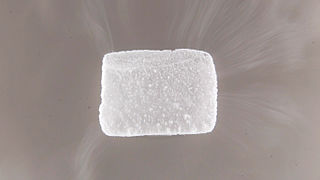
Dry ice colloquially means the solid form of carbon dioxide. It is commonly used for temporary refrigeration as CO2 does not have a liquid state at normal atmospheric pressure and sublimes directly from the solid state to the gas state. It is used primarily as a cooling agent, but is also used in fog machines at theatres for dramatic effects. Its advantages include lower temperature than that of water ice and not leaving any residue (other than incidental frost from moisture in the atmosphere). It is useful for preserving frozen foods (such as ice cream) where mechanical cooling is unavailable.

Mammoth Mountain is a lava dome complex partially located within the town of Mammoth Lakes, California, in the Inyo National Forest of Madera and Mono Counties. It is home to a large ski area primarily on the Mono County side.
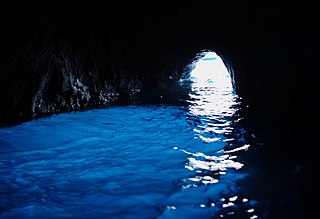
The Blue Grotto is a sea cave on the coast of the island of Capri, southern Italy. Sunlight shining through an underwater cavity is reflected back upward through the seawater below the cavern, giving the water a blue glow that illuminates the cavern. The cave extends some 50 metres into the cliff at the surface, and is about 150 metres (490 ft) deep, with a sandy bottom.

A grotto is a natural or artificial cave used by humans in both modern times and antiquity, and historically or prehistorically. Naturally occurring grottoes are often small caves near water that are usually flooded or often flooded at high tide. Sometimes, artificial grottoes are used as garden features. The Grotta Azzurra at Capri and the grotto at Tiberius' Villa Jovis in the Bay of Naples are examples of popular natural seashore grottoes.

Ponza is the largest island of the Italian Pontine Islands archipelago, located 33 km (21 mi) south of Cape Circeo in the Tyrrhenian Sea. It is also the name of the commune of the island, a part of the province of Latina in the Lazio region.

Hypercapnia (from the Greek hyper = "above" or "too much" and kapnos = "smoke"), also known as hypercarbia and CO2 retention, is a condition of abnormally elevated carbon dioxide (CO2) levels in the blood. Carbon dioxide is a gaseous product of the body's metabolism and is normally expelled through the lungs. Carbon dioxide may accumulate in any condition that causes hypoventilation, a reduction of alveolar ventilation (the clearance of air from the small sacs of the lung where gas exchange takes place) as well as resulting from inhalation of CO2. Inability of the lungs to clear carbon dioxide, or inhalation of elevated levels of CO2, leads to respiratory acidosis. Eventually the body compensates for the raised acidity by retaining alkali in the kidneys, a process known as "metabolic compensation".
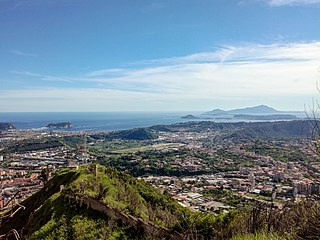
The Phlegraean Fields is a large volcanic caldera situated to the west of Naples, Italy. It is part of the Campanian volcanic arc, which includes Mount Vesuvius on the east side of Naples. The Phlegraean Fields is monitored by the Vesuvius Observatory. It was declared a regional park in 2003.

Lago di Agnano or Lake Agnano was a circular lake, some 6½ km in circumference, which occupied the crater of the extinct volcano of Agnano 8 km west of Naples, Italy. It was apparently not formed until the Middle Ages, as it is not mentioned by ancient writers; it was drained in 1870.
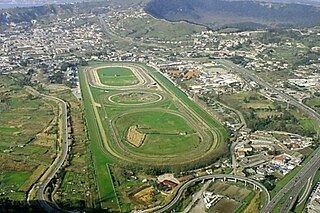
Agnano is a suburb of Napoli, Italy, situated southwest of the city in the Campi Flegrei region. It was popular among both ancient Greeks and Romans and was famed for its hot sulphurous springs.
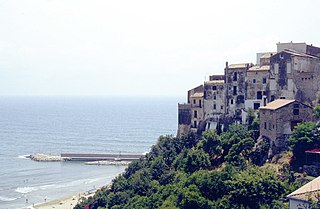
Sperlonga is a coastal town in the province of Latina, Italy, about halfway between Rome and Naples. It is best known for the ancient Roman sea grotto discovered in the grounds of the Villa of Tiberius containing the important and spectacular Sperlonga sculptures, which are displayed in a museum on the site.
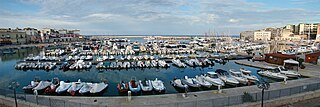
Bisceglie is a city and municipality of 55,251 inhabitants in the province of Barletta-Andria-Trani, in the Apulia region, in southern Italy. The municipality has the fourth highest population in the province and fourteenth highest in the region.
In geology, a mazuku (Swahili for "evil wind") is a pocket of carbon dioxide-rich air that can be lethal to any human or animal life inside. Mazuku is created when carbon dioxide accumulates in pockets low to the ground. CO2 is denser than air, which causes it to flow downhill, hugging the ground like a low fog, and is also undetectable by human olfactory or visual senses in most conditions.
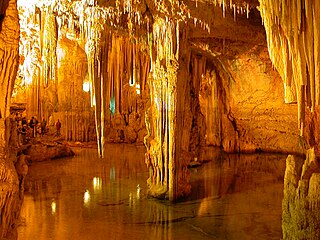
Neptune's Grotto is a stalactite cave near the town of Alghero on the island of Sardinia, Italy. The cave was discovered by local fishermen in the 18th century and has since developed into a popular tourist attraction. The grotto gets its name from the Roman god of the sea, Neptune.

The Addaura cave is a complex of three natural grottoes located on the northeast side of Mount Pellegrino in Palermo, Sicily, Southern Italy. The importance of the complex is due to the presence of cave-wall engravings dated to the late Epigravettian and the Mesolithic.

The Ploutonion at Hierapolis or Pluto's Gate was a ploutonion in the ancient city of Hierapolis near Pamukkale in modern Turkey's Denizli Province. The site was discovered in 1965 by Italian archaeologists, who published reports on their excavations throughout the decade. Following the studies carried out on site in 1998, a geologist of the Italian National Research Council, Luigi Piccardi, recognized that the origin of both the Ploutonion and of the nearby Apollo's Oracle of Hierapolis was linked to the existence of the surface trace of a seismic fault, on which both sanctuaries were purposely built and which was revered as Gateway of Hades. In 2013, it was further explored by Italian archaeologists led by Francesco D'Andria, a professor of archaeology at the University of Salento. As part of a restoration project, a replica of the marble statue of Hades and Cerberus has been restored to its original place. The statue is known to have been there in ancient times.

Tofana di Rozes is a mountain of the Dolomites in the Province of Belluno, Veneto, Italy. Located west of the resort of Cortina d'Ampezzo, the mountain's giant three-edged pyramid shape and its vertical south face, above the Falzarego Pass, makes it the most popular peak in the Tofane group, and one of the most popular in the Dolomites.

The Deer Cave is a natural cave at the Salento coast near the town of Porto Badisco, around 8 km (5.0 mi) south of Otranto in Apulia, Italy. Unknown before 1970, it came to immediate international attention after the discovery of its impressive, innovative and enigmatic complex galleries of prehistoric parietal wall paintings.

Grotta del Gelo is a volcanic cave of Mount Etna which is known for the presence of a large amount of ice. The cave formed in 1614–1624 during a large eruption of the volcano, inside one of the lava flows produced during that eruption. Within the two subsequent decades, ice grew and accumulated in the cave. Today it is a tourist destination.
the Grotto of the Dog claimed our chief attention, because we had heard and read so much about it. Every body has written about the Grotto del Cane and its poisonous vapors, from Pliny down to Smith, and every tourist has held a dog over its floor by the legs to test the capabilities of the place. The dog dies in a minute and a half--a chicken instantly. As a general thing, strangers who crawl in there to sleep do not get up until they are called. And then they don't either. The stranger that ventures to sleep there takes a permanent contract. I longed to see this grotto. I resolved to take a dog and hold him myself; suffocate him a little, and time him; suffocate him some more and then finish him. We reached the grotto at about three in the afternoon, and proceeded at once to make the experiments. But now, an important difficulty presented itself. We had no dog.